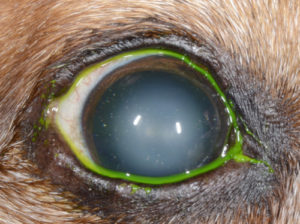ARTICLES
IT’S TOUGH GETTING OLD
Published Tuesday, September 1, 2015

All old dogs have cataracts … right? Well not exactly. All older dogs have a change in their lens called nuclear sclerosis or lenticular sclerosis. This gives the center of their eyes a steel grey or blue hue which can mimic cataracts.
The lens is a crystal clear structure inside the eye which focuses light on the retina. It is involved in accommodation which allows us to focus close up and far away. The lens grows with age and new layers are constantly being deposited on the outside of the lens (just like a tree). The older layers are compressed and moved toward the center of the lens creating a cloudiness to the lens which we see in older pets. This can be seen through the pupil and is often mistaken for cataracts.
Nuclear sclerosis occurs in humans as well and is the reason we need bifocals as we age (a condition known as presbyopia in the human field). Nuclear sclerosis is a normal aging change which occurs in humans and animals. Luckily, nuclear sclerosis will not lead to blindness. It affects only depth perception. As our pets do not read, nuclear sclerosis has little effect on their daily lives. You may notice that they are a little more hesitant on stairs or curbs and may take some additional time to jump up on familiar furniture.
The difference between cataracts and nuclear sclerosis lies in the fact that cataracts will reduce vision and nuclear sclerosis affects only depth perception. No treatment is necessary for nuclear sclerosis in pets.
Another aging phenomena that occurs is called iris atrophy. As we age, many of our muscles thin or atrophy over time. The iris, the colored part of the eye, is a muscle. The central hole in the iris is known as the pupil. As the iris muscle thins, the pupil will no longer be a perfect circle. Also, the pupil will not be able to become pinpoint in very bright light. At times, the muscle becomes so thin that a hole develops in the iris (see picture).
Iris atrophy is a non-painful condition and does not require treatment. With advanced iris atrophy, you may notice that your pet squints in bright light. This occurs because the pupil can no longer constrict down to regulate the amount of light entering the eye. Don’t worry, the light will not damage their eyes.
These normal aging changes usually start around the age of 7 or 8 and are slowly progressive. Luckily, neither change will take away your pet’s vision or comfort.
 Located in the SAVS Facility
Located in the SAVS Facility
